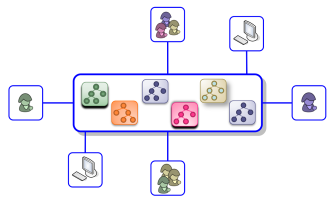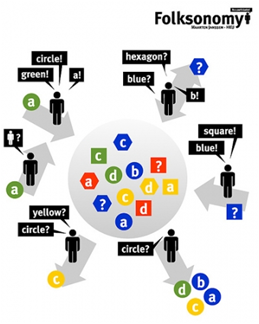Ontological Engineering Ontological Engineering refers to the set of activities that concern the ontology development process, the ontology life cycle, as well as the methodologies, tools and languages required for building ontologies. Ontological Engineering refers to the set of activities that concern the ontology development process, the ontology life cycle, as well as the methodologies, tools and languages required for building ontologies.
Our goal is to provide the guidelines and technologies for more effective and efficient ontology network development, management, and use. With the goal of speeding up the ontology development and improving the management of ontology development projects, our research is focused on identifying prescriptive methodological guidelines that help software engineers and ontology practitioners to build ontologies as well as on providing the necessary technological support. |
||
|
Created under Creative Commons License - 2015 OEG.


 The Semantic Web is an extension of the World Wide Web in which the meaning (semantics) of information and services is defined, making it possible to "understand" and satisfy the requests of people and machines to use the web content. The Semantic Web term was coined in early 2000s to refer to this extension, and since then a large amount of research has been done, providing a number of relevant results in the area.
The Semantic Web is an extension of the World Wide Web in which the meaning (semantics) of information and services is defined, making it possible to "understand" and satisfy the requests of people and machines to use the web content. The Semantic Web term was coined in early 2000s to refer to this extension, and since then a large amount of research has been done, providing a number of relevant results in the area. The fast advances of technologies transform the way scientific research is performed. Data analysis and storage has moved from a paper-based, manual affair to an activity in which computers are vital. As a result, a vast amount of scientific data is being daily collected or produced by computational equipment. No single research organization has enough resources to collect everything; hence the data gathering and archiving processes are distributed and scattered at different places. Neither any single research group has the computational power to process all these data. Besides, collaboration among scientists from different institutions or disciplines is necessary in many occasions to apply a spectrum of methods and models to analyze and process this deluge of information, and the ability to access and reuse datasets, methods, models and results of existing scholarly publications generally ensures more effectiveness and better quality in the research that can be done.
The fast advances of technologies transform the way scientific research is performed. Data analysis and storage has moved from a paper-based, manual affair to an activity in which computers are vital. As a result, a vast amount of scientific data is being daily collected or produced by computational equipment. No single research organization has enough resources to collect everything; hence the data gathering and archiving processes are distributed and scattered at different places. Neither any single research group has the computational power to process all these data. Besides, collaboration among scientists from different institutions or disciplines is necessary in many occasions to apply a spectrum of methods and models to analyze and process this deluge of information, and the ability to access and reuse datasets, methods, models and results of existing scholarly publications generally ensures more effectiveness and better quality in the research that can be done. Terminology and natural language processing are at the basis of many computer applications dealing with domain knowledge, from text generation, information retrieval, machine-assisted translation, and ontology-based language annotation, to ontology localization to mention just a few. In all these areas, the final aim is to allow people to communicate with computers. This communication can be seen from a wide perspective in the new Semantic Web where ontologies have achieved its highest point as the knowledge representations that can be shared by users and machines. In this respect, one of the most challenging issues nowadays is the task of adapting domain ontologies to users of different languages and cultures while preserving the generality of a domain model. Another important issue is derived from the ever-increasing need of improving cross-lingual information extraction methods by means of new innovative approaches that exploit web-based resources (lexica, corpora, translation services, etc.).
Terminology and natural language processing are at the basis of many computer applications dealing with domain knowledge, from text generation, information retrieval, machine-assisted translation, and ontology-based language annotation, to ontology localization to mention just a few. In all these areas, the final aim is to allow people to communicate with computers. This communication can be seen from a wide perspective in the new Semantic Web where ontologies have achieved its highest point as the knowledge representations that can be shared by users and machines. In this respect, one of the most challenging issues nowadays is the task of adapting domain ontologies to users of different languages and cultures while preserving the generality of a domain model. Another important issue is derived from the ever-increasing need of improving cross-lingual information extraction methods by means of new innovative approaches that exploit web-based resources (lexica, corpora, translation services, etc.). In addition to the evolution of the more traditional uses and current trends of the Internet, the Internet is extending its reach to the real world through innovations collectively termed the Internet of Things (IoT). The IoT concept was initially based around enabling technologies such as Radio Frequency Identification (RFID) or wireless sensor and actuator networks (WSAN), but nowadays spawns a wide variety of devices with different computing and communication capabilities. While originating from applications such as supply chain management and logistics, IoT now targets multiple domains including automation, energy, e-health etc. More recent ideas have driven the IoT towards an all encompassing vision to
In addition to the evolution of the more traditional uses and current trends of the Internet, the Internet is extending its reach to the real world through innovations collectively termed the Internet of Things (IoT). The IoT concept was initially based around enabling technologies such as Radio Frequency Identification (RFID) or wireless sensor and actuator networks (WSAN), but nowadays spawns a wide variety of devices with different computing and communication capabilities. While originating from applications such as supply chain management and logistics, IoT now targets multiple domains including automation, energy, e-health etc. More recent ideas have driven the IoT towards an all encompassing vision to